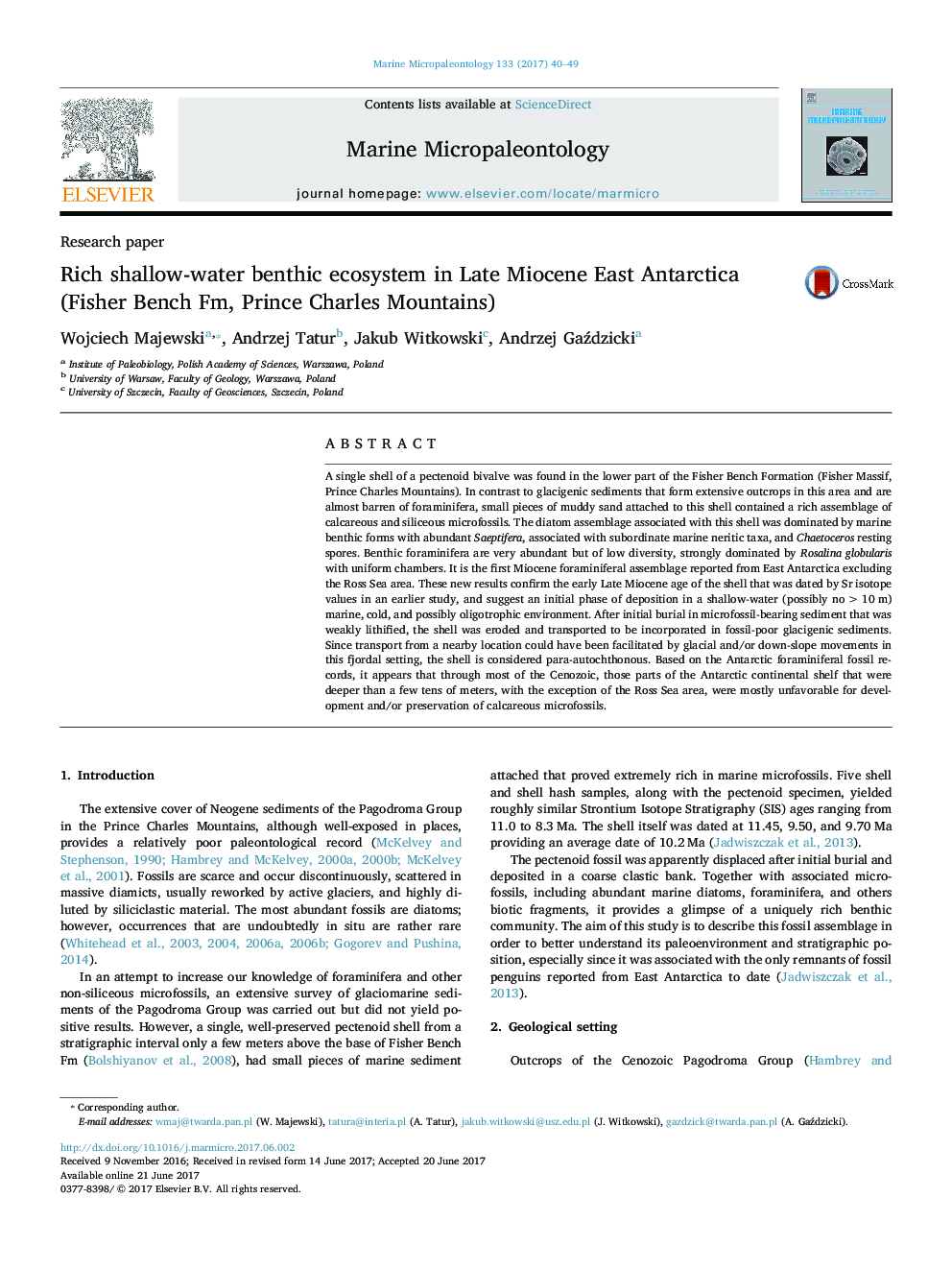| کد مقاله | کد نشریه | سال انتشار | مقاله انگلیسی | نسخه تمام متن |
|---|---|---|---|---|
| 5788160 | 1642152 | 2017 | 10 صفحه PDF | دانلود رایگان |

- Sediment samples from the Cenozoic Padogroma Group in Prince Charles Mts. were almost barren of foraminifera.
- A single well-preserved pectenoid shell was found in the lower part of the Fisher Bench Fm.
- Small pieces of muddy sandy sediment attached to this shell were found to be rich in calcareous and siliceous microfossils.
- Diatom assemblage was composed predominantly of benthic forms, with open marine planktonic taxa accounting for only 8.5%.
- The most abundant diatom genus was Saeptifera represented by five species that were endemic for the Antarctic.
- The foraminiferal assemblage was strongly dominated by Rosalina globularis with uniform chambers.
- It was associated with much less numerous Nonionella, Ammoelphidiella, Buccella, and single individuals of other taxa.
- They are the first Miocene foraminiferal assemblage reported from East Antarctica.
- The pectenoid shell was earlier 87Sr/86Sr dated at 10.2Â Ma that is in line with composition of the marine diatom assemblage.
- It was initially deposited in extremely shallow-water (possibly <Â 10Â m) marine, cold and probably oligotrophic fjord.
- After initial burial the shell underwent gentle transport from a nearby location, so it is considered para-autochthonous.
- Probably, over long periods, parts of Antarctic shelf deeper than a few tens of meters were mostly unfavorable for carbonates.
- A notable regional exception is the Ross Sea area.
A single shell of a pectenoid bivalve was found in the lower part of the Fisher Bench Formation (Fisher Massif, Prince Charles Mountains). In contrast to glacigenic sediments that form extensive outcrops in this area and are almost barren of foraminifera, small pieces of muddy sand attached to this shell contained a rich assemblage of calcareous and siliceous microfossils. The diatom assemblage associated with this shell was dominated by marine benthic forms with abundant Saeptifera, associated with subordinate marine neritic taxa, and Chaetoceros resting spores. Benthic foraminifera are very abundant but of low diversity, strongly dominated by Rosalina globularis with uniform chambers. It is the first Miocene foraminiferal assemblage reported from East Antarctica excluding the Ross Sea area. These new results confirm the early Late Miocene age of the shell that was dated by Sr isotope values in an earlier study, and suggest an initial phase of deposition in a shallow-water (possibly no >Â 10Â m) marine, cold, and possibly oligotrophic environment. After initial burial in microfossil-bearing sediment that was weakly lithified, the shell was eroded and transported to be incorporated in fossil-poor glacigenic sediments. Since transport from a nearby location could have been facilitated by glacial and/or down-slope movements in this fjordal setting, the shell is considered para-autochthonous. Based on the Antarctic foraminiferal fossil records, it appears that through most of the Cenozoic, those parts of the Antarctic continental shelf that were deeper than a few tens of meters, with the exception of the Ross Sea area, were mostly unfavorable for development and/or preservation of calcareous microfossils.
Journal: Marine Micropaleontology - Volume 133, May 2017, Pages 40-49